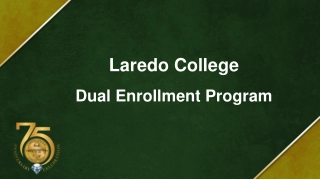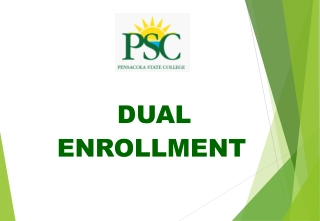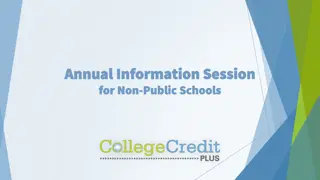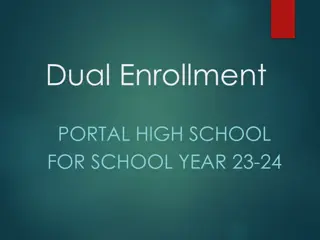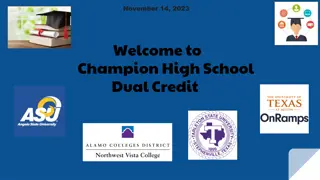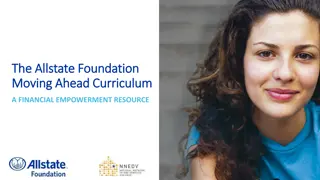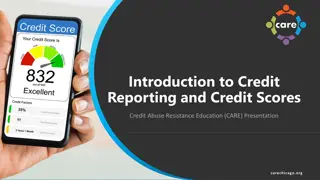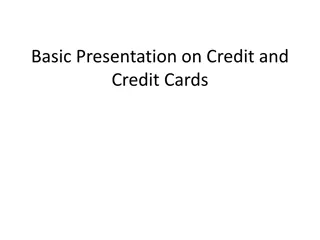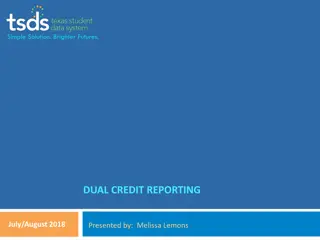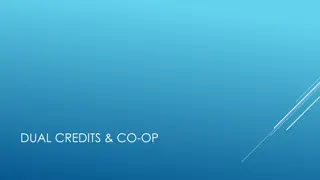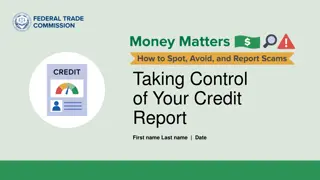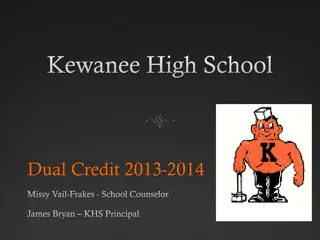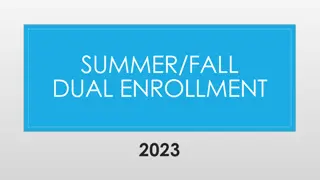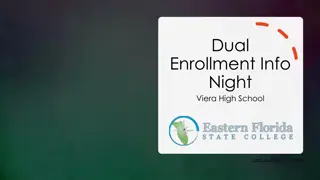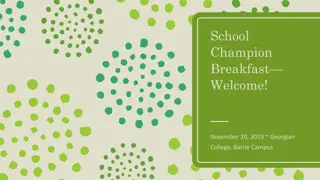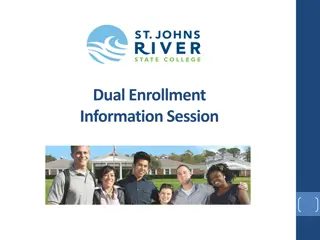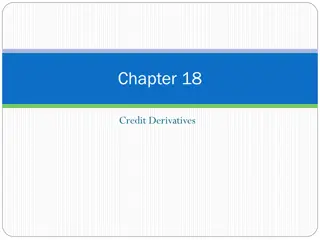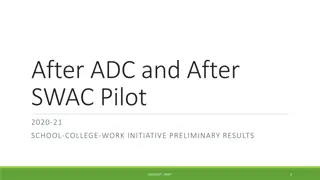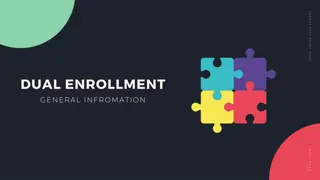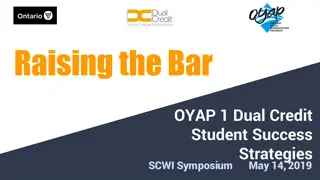Understanding Dual Credit Programs for High School Students
Dual credit programs offer high school students the opportunity to earn college credits while still in high school. This program, offered to junior and senior students at MFHS, allows enrollment in college courses through CTC and/or Sul Ross. Successful completion earns credits towards both high school graduation and regular college coursework. However, students must maintain attendance, academic performance, and integrity standards to fully benefit from dual credit opportunities. Failing a course may have implications on both high school and college transcripts. It is crucial for students to understand the impact of dual credit classes on their future college options to ensure a successful academic journey.
Download Presentation

Please find below an Image/Link to download the presentation.
The content on the website is provided AS IS for your information and personal use only. It may not be sold, licensed, or shared on other websites without obtaining consent from the author. Download presentation by click this link. If you encounter any issues during the download, it is possible that the publisher has removed the file from their server.
E N D
Presentation Transcript
Dual Credit Presentation 2022-2023
What is dual credit? Dual credit gives high school students an opportunity to earn college credit while in high school. At MFHS, this is offered to junior and senior students who meet the requirements. Students enroll in college courses through CTC and/or Sul Ross and those classes earn credit for high school graduation as well as regular college credit. Courses are taught by full-time or adjunct CTC or Sul Ross faculty who meet the Southern Association of Colleges and Schools credential requirements. Classes can be taught in the high school during the school day and are the same content and evaluation as those offered on the college campus. The core classes will transfer to other Texas public colleges and universities.
ATTENDANCE - Extra-curricular activities may conflict. Students are responsible for all materials and must communicate absences with the instructor since only the instructor can authorize an excused absence. Students are responsible for obtaining notes or work from missed lectures. Failure to meet attendance requirements may lower a grade for the semester or may result in failure of the course. This is determined by the instructor. Expectations Responsibility Motivation Self-discipline TIME outside of class for study, research and coursework Scholastic Honesty - Plagiarism, collusion, and cheating will not be tolerated. Students guilty of scholastic dishonesty will be dropped from the course with a grade of F and subject to disciplinary action. - Student Handbook, p. 11 CTC and p.88 SRSU Organization Study Skills
How dual credit classes can impact your future college options Satisfactory Academic Performance - Students must keep their GPA above a 2.0 for college courses. Students must have a 67% or higher completion rate. Not being in compliance can affect financial aid status and keep students from qualifying for grants, loans and scholarships. Excessive Undergraduate Credits toward a Degree - Students may be charged out of state tuition if they exceed the number of credit hours required for their degree program by 30 hours. This would equal 150 hours. Third Course Repeat - Students can be charged out of state tuition when a course is repeated for the third time.
What happens if a student fails a course? Failing a dual credit course will earn the student a failure on their college transcript and their high school transcript. Required high school courses must be made up in an on-level course, in credit recovery, or in a CTC summer session. Seniors who take English 4, Government or Economics will be removed from 2nd semester dual credit classes and placed in credit recovery and on-level classes. Juniors may have the option of retaking the course at CTC in the summer but will be moved out of the Spring semester Dual Credit course.
Your handbook has a section about ADD/DROPS. If you drop the class within the first 2 weeks, you can be changed to another class. Dropping from week 3 to the Withdrawal date will show as a grade of W on your college transcript and will not impact your GPA. However, depending on when you drop, you may not be able to receive high school credit from another class. Please note that you are only allowed a total of 6 W s in college. If you withdraw after the withdrawal date, you will receive a grade of F on your college transcript. What if I change my mind after I start? This is NOT as easy as simply changing a high school course.
Parental Role in Dual Credit Students are transitioning to adults and given more responsibility in courses. They are expected to speak with their instructors when issues arise. Parents are transitioning to a support role. Dual credit courses are actually Central Texas College or Sul Ross courses, therfore, college student privacy rules apply. Student records are confidential and cannot be released to anyone other than the student. This includes parents. For CTC - Students must complete the Student Consent for Release of Academic Records and return it with the registration packet to give named parties access to the student s records for one year. Without the form, instructors will not be able to speak with parents about grades and the grades are not available on Skyward. There are NO progress reports.
Students must be considered college ready to take college courses. TSI scores (prior to 1/11/2021)- Writing & Essay - 340 / 4 Reading - 351 Math 350 TSIA2 scores (after 1/11/2021)- Math - 950 or Diagnostic of 6 ELAR - 945 (or Diag 5) AND 5+ Essay ACT - Composite - 23 with 19 on Eng and Math SAT - EBRW - 480 Math - 530 The TSI will be given to juniors during school March 29 - April 1. Sophomores can sign up to take the test (possibly after school March 29-31) in the counseling office beginning March 2 for $5 a section.
So, what do I do now? Complete all of the steps on the Checklist. Make sure you APPLY ONLINE on the CTC website or Apply Texas for SRSU. You will be e-mailed a student ID number to add to your checklist. Please spend time talking with your child about the requirements and time that will be involved in the class. Ask questions of the instructors, previous/current dual credit students and counselors. Return ALL forms, including the checklist, to Mr. Teets by the due date on the packet. Late forms will not be accepted! Together, decide if this is a commitment you are ready to make. If your child receives accommodations, you must apply with the college to use them for dual credit courses.
Student Handbooks For CTC Got to STUDENTS link, then to "Current High School Students , then to "Dual Credit Programs for CTC information. Can be found at www.ctcd.edu and https://www.sulross.edu/registrar /dual-credit/
Questions? Contact Duane Teets at dteets@mfisd.txed.net or call 830- 693-4375. OR Jennifer Cowfer - CTC; 254-616-3327; JCowfer@ctcd.edu


